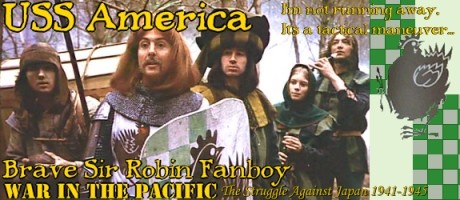CT Grognard
Posts: 694
Joined: 5/16/2010
From: Cape Town, South Africa
Status: offline

|
quote:
ORIGINAL: CT Grognard
Interesting explanation on the design philosophy behind the two-seat fleet fighter (the Fairey Fulmar):
Navies operating aircraft carriers in the mid-1930s were faced with a new difficulty as a result of the technological revolution in aircraft development. The new land-based bombers, which were foreseen at the time as the carrier's greatest possible enemy, were much faster than their predecessors, with increased range and bomb load. Countering the bomber was a problem for the fleet, inasmuch as there was at the time no way of spotting an incoming attack when it was far enough away from the fleet to allow interceptors to be launched from the carrier with any hope of arriving at the enemy's altitude in time to prevent the attack. This was especially a problem for the Royal Navy, inasmuch as its most likely operating areas were the North Sea and the Mediterranean, bodies of water that were small enough to be well within range of land-based aircraft at all times. While radar would eventually solve this problem, its development and use was unseen at the time.
The only answer to this problem that could be seen by the Fleet Air Arm at the time was to create a fleet defense fighter capable of maintaining standing patrols at altitude far enough from the fleet to allow the spotting and interception of incoming raids. The FAA insisted on a two-seat aircraft, since it was believed the pilot would not be able to navigate AND maintain long-distance radio contact with the home carrier for extended periods of time, since long-range radio communication at the time was strictly via Morse Code. Given the limited space on board a carrier, it was also desirable to the fleet defense fighter to be multi-role capable, such as dive-bombing and general reconnaissance.
In 1938 the choice for a new fleet fighter became critical in light of the perceived emergency with war looming. It was decided by the Royal Navy to take up the development of an airplane that already existed and could be modified easily and quickly to become the new fleet defense fighter. The merits of the Fairey P.4/34 and the Hawker Henley - which had first appeared as replacements for the Fairey Battle light bomber - were considered and the P/4/34 design was chosen for further development due to Hawker's commitment to Hurricane fighter production. Fixed armament was specified as eight .303 Vickers K machine guns, and the mount designed for the Hurricane was adopted. The size of the aircraft allowed for a doubling of the ammunition load over that of the Hurricane, and it was capable of flying a 6-hour patrol mission. While the P.4/34 had a .303 machine-gun in the rear cockpit for use by the observer, this was deleted in the fighter version - a decision that would later be regretted.
While the Royal Navy would have preferred a radial engine powerplant, there was none available providing sufficient power, so the moderately-supercharged Rolls-Royce Merlin "H" was specified. This was produced as the Merlin VIII, providing 1,080 hp. Given that the design weighed in at nearly 9,000 pounds - double that of a similarly-powered Hurricane - it was not surprising that the maximum speed was only 265 mph at 7,000 feet. Since the operating strategy for the carriers was to remain out of the operating range of single-seat land-based fighters, this performance was considered sufficient to chase the bombers the airplane was designed to fight.
Fulmar Mk. Is were deployed to the new armoured carrier HMS Illustrious in June 1940 which departed to the Mediterranean in August 1940. Outclassed by contemporary land-based fighters like the Me 109, the 15 Fulmars of 806 Squadron were nevertheless an advance over the three Sea Gladiators being operated by HMS Eagle, which were the sole Fleet Air Arm fighter strength in the eastern Mediterranean at that point.
The Mk I was rapidly replaced by the Mk II in June 1941 which had entered production that spring with a Merlin 30 engine delivering 1,300 hp. While the increased power resulted in an improvement of maximum speed by only 10 mph (i.e. a maximum speed of only 275 mph) it DID have one advantage - it could outclimb the Sea Hurricane just entering service and offer a generally-similar overall performance below 10,000 feet, and could also carry two 250 lb bombs for strike missions (although this very rarely took place in real life).
Throughout the Fulmar's combat service, the armament was seen as too light to be truly effective against bombers like the Junkers Ju-88 and the Savoia-Marchetti S.M. 79. Proposals were made to convert from eight .303 machine guns to four 20mm cannons, but the weight penalty was too much. Another Fulmar had its eight .303 machine guns changed to eight .50-caliber machine guns, but again the weight penalty was too high. Some Fulmars were converted to carry four .50-caliber machine guns.
By the time the Fulmar was withdrawn from front-line fleet service in August 1942, it had destroyed 112 enemy aircraft in air combat and damaged over 80 more. Since this was a third of the total Royal Navy carrier-based fighter victories in the entire war, this represents a considerable success for a fighter that was an emergency makeshift, designed and produced in extreme haste, and which never outperformed its adversaries.
By the way, Specification P.4/34 was for a "light bomber and close air support aircraft" capable of carrying 500 lbs in bombs and stressed for dive-bombing.
Fairey, Gloster and Hawker all submitted designs. Only the Fairey and Hawker designs were given authorisation to construct prototypes.
The Fairey P.4/34 was a low-wing all-metal monoplane powered by a 1,030HP Rolls-Royce Merlin III engine, with a crew of two accommodated in tandem under a long-glazed canopy. It was very similar to Fairey's earlier Battle light bomber, but was smaller and had a wide-track, inwards-retracting undercarriage. It had one fixed, forward-firing .303-in Vickers K and a flexible rear-firing .303-in Vickers K in the back, and could carry two 250lb bombs mounted under its wings. Maximum speed was 283 mph with a stall speed of 55 mph and a range of 800 nautical miles. Climb rate waThe first prototype flew in January 1937.
The competing design, the Hawker Henley, was interesting. Since the specification asked for a modest bomb load, Hawker decided performance was paramount and decided to design an aircraft similar in size and performance to the Hawker Hurricane (by then already in an advanced design stage). As a result, the Hawker Henley featured exactly the same outer wing panel and tainplane jigs as the Hurricane. Both used the Rolls-Royce Merlin "F" inline engine which offered the best power/weight ratio and minimal frontal area. The wing was mid-set with a retractable tailwheel-type landing gear, and seating was provided for a pilot and an observer/air gunner. The prototype first flew in March 1937 and was subsequently refitted with stressed-skin wings and a Merlin I engine, and further test flights confirmed the excellence of its overall performance - a maximum speed of 294 mph and a 940 nautical mile range.
The main differences between the designs appear to be that the Fairey P.4/34 was slightly larger, heavier and slower than the Hawker Henley, but had a slightly better rate of climb (also, a larger wing area).
As soon as the two prototypes had flown, however, the Air Ministy decided in 1937 they no longer required a light bomber and the Hawker Henley was re-designated as a target tug, and its production was subcontracted to Gloster - 200 were eventually built.
The Fairey P.4/34 design, as stated earlier, was then accepted the very next year as a fleet defense fighter with some minor modifications and designated the Fairey Fulmar I.
The main changes were to reduce the wingspan on the Fairey P.4/34 from 47 ft to 46 ft and to install eight wing-mounted .303-in caliber machine guns with 400 rounds each as well as making some aerodynamic changes and installing the moderately-supercharged Merlin VIII engine.
The increased weight from the eight .303-in machine guns and ammunition had the result of increasing the loaded weight of the aircraft from 8,787 lbs to 9,672 lbs - and reducing maximum speed to 265 mph.
Ultimately, the Fairey Fulmar Mk I arose because of a number of factors:
1) It was an existing prototype and simple modifications meant it would be available quickly;
2) A superior competing design (the Hawker Henley) was not considered since Hawker was focusing on Hurricane production.
|
 Printable Version
Printable Version

















 New Messages
New Messages No New Messages
No New Messages Hot Topic w/ New Messages
Hot Topic w/ New Messages Hot Topic w/o New Messages
Hot Topic w/o New Messages Locked w/ New Messages
Locked w/ New Messages Locked w/o New Messages
Locked w/o New Messages Post New Thread
Post New Thread